| Article ID | Journal | Published Year | Pages | File Type |
|---|---|---|---|---|
| 286519 | Journal of Rock Mechanics and Geotechnical Engineering | 2015 | 9 Pages |
In this paper, an experimental study for an eccentrically loaded circular footing, resting on a geogrid reinforced sand bed, is performed. To achieve this aim, the steel model footing of 120 mm in diameter and sand in relative density of 60% are used. Also, the effects of depth of first and second geogrid layers and number of reinforcement layers (1–4) on the settlement-load response and tilt of footing under various load eccentricities (0 cm, 0.75 cm, 1.5 cm, 2.25 cm and 3 cm) are investigated. Test results indicate that ultimate bearing capacity increases in comparison with unreinforced condition. It is observed that when the reinforcements are placed in the optimum embedment depth (u/D = 0.42 and h/D = 0.42), the bearing capacity ratio (BCR) increases with increasing load eccentricity to the core boundary of footing, and that with further increase of load eccentricity, the BCR decreases. Besides, the tilt of footing increases linearly with increasing settlement. Finally, by reinforcing the sand bed, the tilt of footing decreases at 2 layers of reinforcement and then increases by increasing the number of reinforcement layers.
